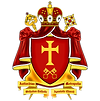On the Fall of Man and their Restoration
- Great Church
- Jun 11, 2021
- 3 min read
Updated: Aug 13

The following is a commentary on the First Book of Moses by Ecumenical Metropolitan of Antioch, Auriel Jones. This commentary on the First Book of Moses has been written and published for the sake of understanding the background of the Fall of Man, and humanity's restoration in God through the Christ in the New Testament.
Within the contents of the First Book of Moses—often known as Origin or Genesis—God, through undetermined time according to the Hebrew terminology for "day", established an oasis for Adam and Eve which is purported to have spanned the Arabian Peninsula and Middle East, and perhaps, even North Africa. Setting Adam and Eve into this garden, He commanded them to not eat from the fruit of the tree of the knowledge of good and evil.
Having been instructed to not do so, and instead, learn of good and evil through observation and wisdom from God as the Evil One was cast out from the Divine Council for attempting to usurp their creator, this fallen seraph descended before them. He descended before Adam and Eve because—in rebellion against the Most Holy and Sovereign Trinity—he sought to usurp the goodness in all that was visible and invisible, known and unknown; by these acts, assisting in the corruption of creation, he could thereby accuse the creation and Creator of being false in nature.
Descending, he approached Adam and Eve, and spoke to Eve that she might adhere to her own knowledge against God's and Adam's through God, as they already in their own will sought to explore the expanse of the world knowing good and evil through instruction from the Lord God, yet lusting for more before their appointed time.
Eve—succumbing to her own knowledge in ignorance and lacking fear of the seraph for having access to God and all the heavenlies with Adam—joins with Adam in partaking of the fruit from this tree, which effectively transgressed the plan of God.
By pride and arrogance, which exploited the seed of sin which already sought to grow in free-willed creations, they had become doomed to death; yet, what death was this? In essence, this may be interpreted as spiritual death, and even the physical death. Gleaming toward the New Testament, this may be witnessed once more in Jesus the Christ being tempted by His own creation, to fulfill His own plan against the unity with the Father and Holy Spirit, saying He would surely not fail; nevertheless, as the Christ is God, this did not come to pass, because God is perfect in harmony and unity.
Having partook of the fruit from this tree, and becoming doomed to death, they felt their nakedness which in the Hebrew tradition references exposure and shame. God—seeing all and knowing all, respecting the desires of His created beings to do as they will though providing knowledge of consequence—casts them from this oasis and sets the male over the female as a result; whereas there was equality in God's perfect order, this corrupted creation suffered inequality through the ages until the fleshly birth of Jesus the Christ.
This creation suffered inequality in all its varieties until the fleshly birth of Jesus the Christ, because it was prophesied to be so in the protoevangelion. By His coming out of the holy desire to restore creation in its pride and arrogance, He served as the perfect example for humanity to restore themselves to union with the Most Holy and Sovereign Trinity, and labor toward the restoration of creation and preservation of souls from eternal damnation, which was originally purposed for the Evil One and those that followed him from the Throne of God.
In His death, He descended to rescue those righteous yet misguided souls from their limbo, bringing them into His presence after resurrecting from being bruised after crushing the serpent's head.




Comments